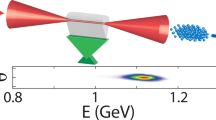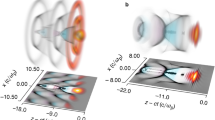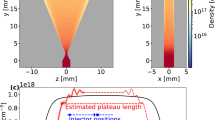Abstract
In laser-plasma-based accelerators1, an intense laser pulse drives a large electric field (the wakefield) which accelerates particles to high energies in distances much shorter than in conventional accelerators. These high acceleration gradients, of a few hundreds of gigavolts per metre, hold the promise of compact high-energy particle accelerators. Recently, several experiments have shown that laser-plasma accelerators can produce high-quality electron beams, with quasi-monoenergetic energy distributions at the 100 MeV level2,3,4. However, these beams do not have the stability and reproducibility that are required for applications. This is because the mechanism responsible for injecting electrons into the wakefield is based on highly nonlinear phenomena5, and is therefore hard to control. Here we demonstrate that the injection and subsequent acceleration of electrons can be controlled by using a second laser pulse6. The collision of the two laser pulses provides a pre-acceleration stage which provokes the injection of electrons into the wakefield. The experimental results show that the electron beams obtained in this manner are collimated (5 mrad divergence), monoenergetic (with energy spread <10 per cent), tuneable (between 15 and 250 MeV) and, most importantly, stable. In addition, the experimental observations are compatible with electron bunch durations shorter than 10 fs. We anticipate that this stable and compact electron source will have a strong impact on applications requiring short bunches, such as the femtolysis of water7, or high stability, such as radiotherapy with high-energy electrons8,9 or radiography10 for materials science.
This is a preview of subscription content, access via your institution
Access options
Subscribe to this journal
Receive 51 print issues and online access
$199.00 per year
only $3.90 per issue
Buy this article
- Purchase on Springer Link
- Instant access to full article PDF
Prices may be subject to local taxes which are calculated during checkout



Similar content being viewed by others
References
Tajima, T. & Dawson, J. M. Laser electron accelerator. Phys. Rev. Lett. 43, 267–270 (1979)
Mangles, S. et al. Mono-energetic beams of relativistic electrons from intense laser–plasma interactions. Nature 431, 535–538 (2004)
Geddes, C. G. R. High-quality electron beams from a laser wakefield accelerator using plasma-channel guiding. Nature 431, 538–541 (2004)
Faure, J. et al. A laser-plasma accelerator producing monoenergetic electron beams. Nature 431, 541–544 (2004)
Pukhov, A. & Meyer-ter-Vehn, J. Laser wake field acceleration: the highly non-linear broken-wave regime. Appl. Phys. B 74, 355–361 (2002)
Esarey, E., Hubbard, R. F., Leemans, W. P., Ting, A. & Sprangle, P. Electron injection into plasma wake fields by colliding laser pulses. Phys. Rev. Lett. 79, 2682–2685 (1997)
Brozek-Pluska, B., Gliger, D., Hallou, A., Malka, V. & Gauduel, Y. A. Direct observation of elementary radical events: low- and high-energy radiation femtochemistry in aqueous solutions. Radiat. Chem. 72, 149–159 (2005)
DesRosiers, C., Moskvin, V., Bielajew, A. F. & Papiez, L. 150–250 MeV electron beams in radiation therapy. Phys. Med. Biol. 45, 1781–1805 (2000)
Glinec, Y. et al. Radiotherapy with laser-plasma accelerators: Monte-Carlo simulation of dose deposited by an experimental quasi-monoenergetic electron beam. Med. Phys. 33, 155–162 (2006)
Glinec, Y. et al. High resolution γ-ray radiography produced by a laser-plasma driven electron source. Phys. Rev. Lett. 94, 025003 (2005)
Tsung, F. S. et al. Near-GeV-energy laser-wakefield acceleration of self-injected electrons in a centimeter-scale plasma channel. Phys. Rev. Lett. 93, 185002 (2004)
Sun, G., Ott, E., Lee, Y. C. & Guzdar, P. Self-focusing of short intense pulses in plasmas. Phys. Fluids 30, 526–532 (1987)
Faure, J. et al. Observation of laser pulse shortening in nonlinear plasma waves. Phys. Rev. Lett. 95, 205003 (2005)
Hsieh, C.-T., et al. Tomography of injection and acceleration of monoenergetic electrons in a laser-wakefield accelerator. Phys. Rev. Lett. 96, 095001 (2006)
Leemans, W. P., et al. GeV electron beams from a centimetre-scale accelerator. Nature Phys. 2, 696–699 (2006)
Umstadter, D., Kim, J.-K. & Dodd, E. Laser injection of ultrashort electron pulses into wakefield plasma waves. Phys. Rev. Lett. 76, 2073–2076 (1996)
Fubiani, G., Esarey, E., Schroeder, C. B. & Leemans, W. P. Beat wave injection of electrons into plasma waves using two interfering laser pulses. Phys. Rev. E 70, 016402 (2004)
Kotaki, H., Masuda, S., Kando, M., Koga, J. K. & Nakajima, K. Head-on injection of a high quality electron beam by the interaction of two laser pulses. Phys. Plasmas 6, 3296–3302 (2004)
Semuchin, S. & Malka, V. High density gas jet nozzle design for laser target production. Rev. Sci. Instrum. 72, 2961–2965 (2001)
Glinec, Y., et al. Absolute calibration for a broadrange single shot electron spectrometer. Rev. Sci. Instrum. 77, 103301 (2006)
Acknowledgements
We thank J.-P. Rousseau, F. Burgy, B. Mercier, A. Tafzi, D. Douillet, T. Lefrou, F. Alahyane and J.-L. Charles. J.F. thanks S. Sebban for his patient help with the experiment. J.F. acknowledges discussions with G. Fubiani. We also acknowledge the support of the European Community Research Infrastructure Activity under the FP6 “Structuring the European Research Area” programme (CARE).
Author information
Authors and Affiliations
Corresponding author
Ethics declarations
Competing interests
Reprints and permissions information is available at www.nature.com/reprints. The authors declare no competing financial interests.
Supplementary information
Supplementary Information
This file contains figures and methods. Figure S1 shows a schematics of the experimental set-up. Figure S3 shows a graph showing the electron peak energy and plasma density versus longitudinal position. Figure S3 shows results of the simulations of colliding pulse injection. Supplementary Methods discuss a description of the model which was used for simulating the injection and acceleration of electrons in the colliding pulse experiment. (PDF 747 kb)
Rights and permissions
About this article
Cite this article
Faure, J., Rechatin, C., Norlin, A. et al. Controlled injection and acceleration of electrons in plasma wakefields by colliding laser pulses. Nature 444, 737–739 (2006). https://doi.org/10.1038/nature05393
Received:
Accepted:
Issue Date:
DOI: https://doi.org/10.1038/nature05393
This article is cited by
-
Notable improvements on LWFA through precise laser wavefront tuning
Scientific Reports (2023)
-
Efficient plasma electron accelerator driven by linearly chirped multi-10-TW laser pulses
Scientific Reports (2023)
-
Controlled acceleration of GeV electron beams in an all-optical plasma waveguide
Light: Science & Applications (2022)
-
Vacuum laser acceleration of super-ponderomotive electrons using relativistic transparency injection
Nature Communications (2022)
-
Nanoparticle-insertion scheme to decouple electron injection from laser evolution in laser wakefield acceleration
Scientific Reports (2022)
Comments
By submitting a comment you agree to abide by our Terms and Community Guidelines. If you find something abusive or that does not comply with our terms or guidelines please flag it as inappropriate.



